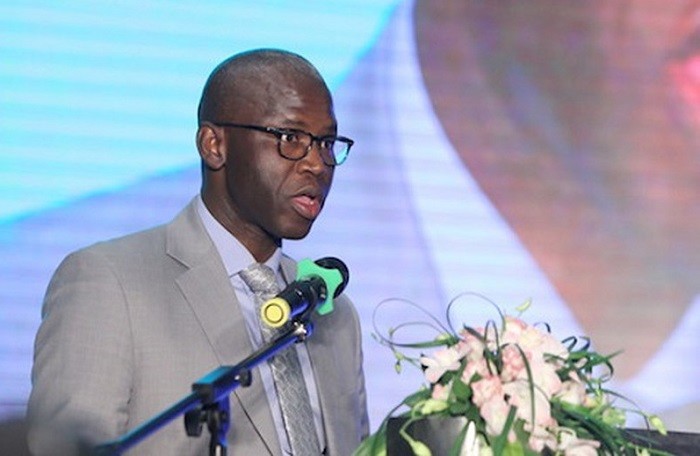At the “2nd High-level meeting - Viet Nam Energy Partnership Group (VEPG) on the Future of Sustainable Energy Sector for Viet Nam,” Mr. Ousmane Dione gave some assessments about the development of energy in Viet Nam over the past time and the challenges to be solved in the coming time.

Mr. Ousmane Dione, Country Director of the World Bank (WB) in Viet Nam
According to him, Viet Nam is a story of success in the world for the development of energy sector over the past few decades. Two aspects should be emphasized in this story are rural electrification and sector reform.
Regarding rural electrification, Viet Nam’s access-to-electricity rate has increased from 14% in 1993 to over 99% in 2018. Over 25 years, more than 14 million households or 60 million people have been supplied power from the national grid. This is really a miracle.
The financial requirement for the energy sector is enormous. As of 2010, the Power sector has invested USD 80 billion in power generation, transmission and distribution. From now to 2030, the Sector will need to further raise about USD 150 billion.
However, Viet Nam’s power consumption has been relatively low compared to international standards. For example, current per-capita power consumption is about 1,700kWh per year - this figure is only equivalent to 1/3 of China’s and 1/5 of Australia’s. The economy will continue to strongly grow and people’s lives will be better with power demand annually increasing by about 8% in the next decade.
Electricity price in Viet Nam has been lower than the capital recovery rate and the Viet Nam Electricity (EVN) currently does not receive direct subsidy from the Government. Therefore, EVN and the Power sector have been effectively and efficiently using ODA capital.
Regarding the Sector’s reform, about a decade ago, the Government came up with a clear roadmap for executing competition and restructure. The driving force is to shift from a vertical sector monopoly market structure to a fully competitive electricity market.
“I would like to praise the Government of Viet Nam in continuing its comprehensive commitments towards a competitive electricity market. We have gone half way and by 2020, the wholesale electricity market will begin to be fully operated. The experience with market liberalization has been very positive, contributing to the efficient operation of EVN as a public utility company with proper technical and operational capacity, while allowing the private sector to participate in the electricity generation market,” he said.
The challenge of Viet Nam is the future and the energy sector may oversleeping on its achievements gained from the past. The prerequisite challenges to be overcome by the Sector in the next two decades are to ensure reaching its targets for sustainable, clean, reliable and affordable power supply for the Vietnamese people.
The two main challenges are: How to meet the energy needs in the future while ensuring the Government’s targets for reducing greenhouse gas emissions and criteria in climate change; and how to mobilize large financial resources (estimated at USD 8 billion) each year in order to meet the rapidly-increasing demand for power.
In response to these challenges, the World Bank’s strategy in the energy area focuses on two initiatives.
The first one is on energy transition, the WB supports the Government in determining and performing proper technical, financial and social solutions to reduce use of coal in the future, mainly in power generation.
This is a challenge difficult to be quickly resolved. The Government should perform four key tasks in parallel with reducing the use of coal-fired thermal power including: Expanding renewable energy (particularly wind and solar power); promoting natural gas and liquefied natural gas (LNG); enhancing investments in energy efficiency; and promoting regional power trading, particularly with Laos and Southern region of China.
The second one is that finance from public sector and ODA may not meet the huge demand on investment of the Power sector. Thus, through the “Initiative of Maximizing Finance for Development (MFD),” the WB will support the Government in finding and performing solutions that bring more private investment and commercial finance for the Power sector.
The MFD initiative is particularly appropriate in the context of Viet Nam’s graduation in the International Development Association (IDA) in recent time and difficulties in obtaining government guaranteed loans due to the government’s policy on public debt ceiling.
The three pillars need to be addressed to mobilize more commercial and private capital in the Power sector: Developing and launching the program of Independent Power Producer (IPP) competing in power generation as part of the Power Master Plan No. VIII with the contract framework capable to attract both domestic and international investment on a large scale; preparing for state-owned enterprises trading electricity and gas to access commercial finance through credit rating and government bond issuance; support the reform of banking and financial markets in order to improve the available resources of local currency, which is so essential for both project finance and corporate finance in energy investment projects.
The World Bank is ready to support the Vietnamese Government in its agenda for Initiative of Energy Transition and Maximizing Finance for Development and will coordinate with the VEPG on important policy issues.